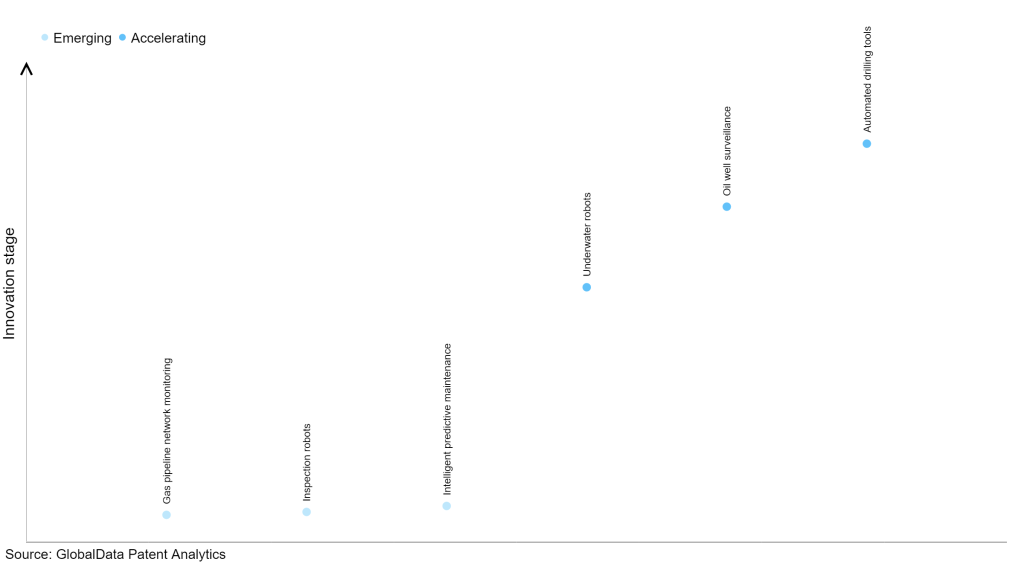The oil & gas industry continues to be a hotbed of patent innovation. Activity is driven by digitalization, analytics, and cybersecurity, and growing importance of technologies such as wearable technologies, IP cameras, and advanced analytics. In the last three years alone, there have been over 327,000 patents filed and granted in the oil & gas industry, according to GlobalData’s report on Internet of Things in oil & gas: worksite network monitoring. Buy the report here.
However, not all innovations are equal and nor do they follow a constant upward trend. Instead, their evolution takes the form of an S-shaped curve that reflects their typical lifecycle from early emergence to accelerating adoption, before finally stabilizing and reaching maturity.
Identifying where a particular innovation is on this journey, especially those that are in the emerging and accelerating stages, is essential for understanding their current level of adoption and the likely future trajectory and impact they will have.
65+ innovations will shape the oil & gas industry
According to GlobalData’s Technology Foresights, which plots the S-curve for the oil & gas industry using innovation intensity models built on over 201,000 patents, there are 65+ innovation areas that will shape the future of the industry.
Within the emerging innovation stage, gas pipeline network monitoring, inspection robots and intelligent predictive maintenance are disruptive technologies that are in the early stages of application and should be tracked closely. Underwater robots, oil well surveillance and automated drilling tools are some of the accelerating innovation areas, where adoption has been steadily increasing.
Innovation S-curve for Internet of Things in the oil & gas industry

Worksite network monitoring is a key innovation area in Internet of Things
Worksite monitoring refers to the process of using various sensors and technologies to monitor and collect data related to the conditions and activities at a worksite. The data can then be used for various purposes including safety management, performance optimization, and risk control.
GlobalData’s analysis also uncovers the companies at the forefront of each innovation area and assesses the potential reach and impact of their patenting activity across different applications and geographies. According to GlobalData, there are 120+ companies, spanning technology vendors, established oil & gas companies, and up-and-coming start-ups engaged in the development and application of worksite network monitoring.
Key players in worksite network monitoring – a disruptive innovation in the oil & gas industry
‘Application diversity’ measures the number of applications identified for each patent. It broadly splits companies into either ‘niche’ or ‘diversified’ innovators.
‘Geographic reach’ refers to the number of countries each patent is registered in. It reflects the breadth of geographic application intended, ranging from ‘global’ to ‘local’.
Patent volumes related to worksite network monitoring
Source: GlobalData Patent Analytics
Sinopec Petroleum Engineering is one of the leading patent filers in worksite network monitoring for the oil & gas industry. The company has a massive operation in the energy sector spanning from oil and gas production, refining, petrochemicals, to renewables. This necessitates efficient management of the workforce to maintain continuity in operations. The company has adopted newer digital technologies such as artificial intelligence (AI), cloud, and the Internet of Things (IoT) to streamline its operations. Some other key patent filers in the space include China Petrochemical and China National Petroleum.
In terms of application diversity, Komatsu leads the pack, while Halliburton and China Petrochemical stood in the second and third positions, respectively. Komatsu is a prominent equipment and solutions provider for the energy sector. Its product portfolio includes KOMTRAX, a wireless monitoring system, which supports fleet management and preventive maintenance. The company also offers KomVision, a human detection and collision mitigation system, which makes worksite operations more efficient.
By means of geographic reach, SICPA, PPG and Halliburton are among the leaders. Halliburton offers equipment, sensors, and software solutions for oilfield operations. The company’s flagship software, DecisionSpace 365, allows for agile asset management in the energy sector.
Skilled labor as well as expensive equipment are employed in oil and gas operations. A worksite monitoring solution helps the operators avoid mishaps and loss to life and property, while ensuring operational agility.
To further understand the key themes and technologies disrupting the oil & gas industry, access GlobalData’s latest thematic research report on Internet of Things in Oil & Gas.
Data Insights
From

The gold standard of business intelligence.
Blending expert knowledge with cutting-edge technology, GlobalData’s unrivalled proprietary data will enable you to decode what’s happening in your market. You can make better informed decisions and gain a future-proof advantage over your competitors.



